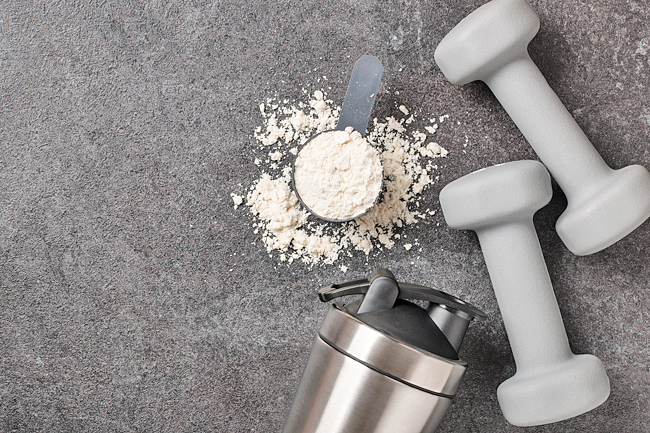CNA – Proteins play a crucial role in the body, serving multiple vital functions. They serve as the fundamental building blocks for essential components like hair, skin, nails, organs, and muscles. Additionally, proteins actively promote muscle growth and contribute to controlling our appetite.
These days, there are a wide range of protein supplements exists to aid in fulfilling our daily nutritional requirements. These supplements come in various forms, such as protein powders, ready-to-drink shakes, and protein bars.
Nonetheless, it is important to emphasise that while these products offer convenient protein sources, they should not be viewed as complete replacements for healthy protein-rich foods.
Rather, they are designed to complement your regular intake and help you achieve your dietary goals. Combining these supplements with a balanced diet ensures that you adequately meet your protein needs and maintain overall well-being.
ROLE OF PROTEIN POWDER
Protein powders are concentrated sources of protein and are produced from a variety of sources. Whey protein is made from dairy, while plant-based protein powders are usually made from soy or a blend of other proteins, such as rice, quinoa, pea, or flax seed.
Many of these products provide about 20-30 grammes of protein per serving, and they’re commonly used to create shakes and smoothies, although they can be stirred into many other foods, too.
The powder format lets you control how much protein you want to mix into foods such as shakes, smoothies, oatmeal, yoghurt, and soup.

MULTIPLE BENEFITS
There is plenty of research to support the benefits of protein supplementation:
Protein can help support muscle strength and build muscle mass after resistance training.And when it comes to plant-based versus dairy protein supplementation, one study comparing vegan and omnivore athletes found both soy isolate protein and whey protein equally effective for muscle building.
Protein supplementation has also been found to have a satiating effect, helping suppress appetite and control hunger. For this reason, protein powders can be incorporated into weight management plans within a reduced-calorie diet.
In overweight and obese patients, protein supplementation resulted in significant reductions in body weight and total fat mass, according to a systematic review.
In older adults, protein supplementation has been shown to be an effective means to prevent and counteract sarcopenia, or loss of muscle mass, according to one study.
Whether your goal is weight loss, weight gain, or simply better health, consumers of all kinds can benefit from both plant-based and animal-based protein powders.
HOW TO USE PROTEIN POWDER
While it’s important to include other sources of protein in your diet – such as fish, poultry, lean meats and plant proteins, including beans, lentils, and tofu – protein powders are a convenient way to add protein to lots of foods. They can be added to dishes such as oatmeal, soups, and baked goods.
When mixed as a shake, protein powder is an easy way to incorporate high-quality protein into your diet.
In fact, many athletes and gym-goers use protein supplements for weight gain or post-workout recovery.
Protein shakes can be used as a way to fuel before or to refuel after exercise.
IT LASTS LONG
Store your protein powder in a cool, dry part of your pantry to ensure it will stay fresh.
With proper storage, protein powders can be stored for many months, but do pay attention to any ‘use by’ dates on the package.
GET CREATIVE BY ADDING THESE
Fruits and vegetables: Aside from the typical berries or bananas, you might try mixing it up with less-typical fruits like kiwi, pomegranate seeds, guava, or melon. Vegetables like cooked carrots, pumpkin, beets, or butternut squash are great shake boosters because they’re mildly sweet.
And baby greens – like baby spinach – are mild in flavour and make great shake add-ins, too. Plus, it’s an easy way to get servings of fruits and vegetables each day.
Beneficial fats: Seeds like flax, hemp, chia, or sunflower add a bit of texture to your shake and give a little boost of minerals (especially copper and zinc) and omega-3 fatty acids.
Nut butters – such as almond, walnut, or pistachio – also contribute zinc and copper, along with some protein and fibre, too. Avocado is another beneficial fat source that adds a great smooth texture to your shake.
Additional fibre: Rolled oats, chia seeds, flax seeds, apples, and berries help to boost your soluble fibre intake – that’s the type of fibre that traps water and swells, contributing to feelings of fullness.
Carrots, most other seeds, and leafy greens can boost the amount of insoluble fibre in your diet – the type of fibre that helps keep you regular.
You can also add certain powdered fibre supplements if they match the flavour profile of your shake.
Spices and herbs: Try a dash of sweet cinnamon, nutmeg, allspice, or clove, or add some spicy heat with ginger or even a dash of white pepper.
Since they are plant products, spices also contribute phytonutrients and antioxidants.
Herbs may not be something you have thought about adding to your shake, but there are plenty of herbs that work really well, such as mint, rosemary, thyme, or basil.
Extracts and zest: A little fresh lemon or orange zest adds a bright, fresh flavour to your shake, and there are some healthy oils in citrus peel, too. I also like to keep all kinds of extracts on hand – like pure vanilla, almond, coconut, and peppermint for an extra flavour boost.
Digestive support: Consider giving your shake a digestive boost. Yoghurt contains probiotics – the good bacteria that help support digestive health.
Ginger and peppermint are both known to aid the digestive process. Chia seeds are a very rich source of soluble fibre, which supports the growth of the good bacteria in your intestines. – Susan Bowerman




